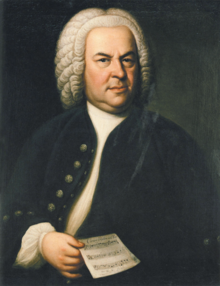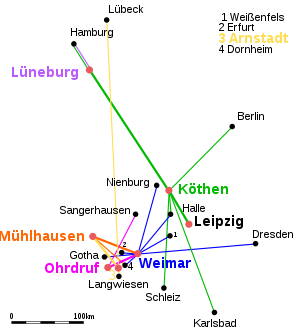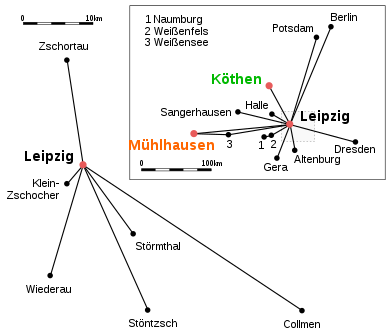Johann Sebastian Bach
![]()
The title of this article is ambiguous. For other meanings, see Johann Sebastian Bach (disambiguation).
Johann Sebastian Bach (* 21 Marchjul. / 31 March 1685greg. in Eisenach, Saxe-Eisenach; † 28 July 1750 in Leipzig, Electoral Saxony) was a German composer, cantor, court concertmaster, violinist, and organ and harpsichord virtuoso of the Baroque period from Thuringia. In his main period of activity he was Thomaskantor at Leipzig. He is the most prominent representative of the Bach family of musicians and is considered today to be one of the best known and most important musicians of all. Professional musicians in particular often regard him as the greatest composer in the history of music. His works influenced subsequent generations of composers and inspired music-making artists to countless arrangements.
During his lifetime Bach was highly regarded as a virtuoso, organist and organ inspector, but his compositions were known only to a relatively small circle. After Bach's death, his works fell into oblivion for decades and were rarely performed in public. After the composers of the Viennese Classical period had tackled parts of Bach's work, the Bach Renaissance began among the general public with the revival of the St. Matthew Passion conducted by Felix Mendelssohn Bartholdy in 1829. Since the middle of the 19th century, his works have been part of the permanent repertoire of classical music worldwide.
His best-known works include The Well-Tempered Clavier, the St. Matthew Passion, The Art of the Fugue, his Christmas Oratorio, the Brandenburg Concertos, and many cantatas.
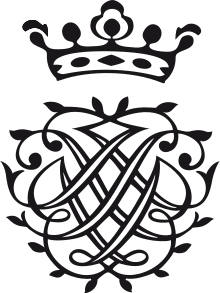
Bach's self-designed seal with the first letters of his name, JSB, interwoven in mirror image.
Live
Eisenach (1685-1695)
Johann Sebastian Bach descends from the widespread Lutheran central German Bach family, whose paternal ancestors and relatives, who can be traced back to the 16th century, were almost all active as cantors, organists, town pipers, members of court chapels or clavichord/harpsichord and lute makers in the area between the Werra and Saale rivers. The Bach family tree can be traced back to his great-great-grandfather Veit (or Vitus) Bach, who left Hungary or Moravia/Slovakia as a Protestant religious refugee and settled as a baker in Wechmar near Gotha, the home of his ancestors. He already played the "Cithrinchen", a plucked string instrument. His son Johannes was not only active as a baker, but also as a "Spielmann". The other descendants were all musicians. Johann Sebastian Bach himself wrote a chronicle about the "Origin of the musical Bach family" with short biographies of 53 family members in 1735.
Johann Sebastian was the youngest of eight children of Johann Ambrosius Bach (1645-1695) and his wife Elisabeth, née Lemmerhirt (1644-1694). His father was a town piper in Eisenach and court trumpeter in the small chapel of Duke Johann Georg I and then Duke Johann Georg II of Saxe-Eisenach. At the time of Johann Sebastian Bach's birth, the Juliancalendar was still in use in the Protestant territories of Germany, including his birthplace Eisenach. Thus his date of birth is usually given as the locally valid date, 21 March 1685; according to the Gregorian calendar, his date of birth is 31 March. Since the Protestant imperial states adopted the Gregorian calendar in 1700, all dates in Bach's biography since 1700, including Bach's date of death, are exclusively Gregorian. The house where Bach was born, in what was then Fleischgasse (now Lutherstrasse 35), no longer exists. Two days after his birth Johann Sebastian Bach was baptized in the Georgenkirche in Eisenach. He received his two first names from the two godparents, Sebastian Nagel, town piper of Gotha, and the princely Eisenach forestry official Johann Georg Koch. His call name was Sebastian.
Although Eisenach had only about 6000 inhabitants at the time of Bach's birth, it had quite an important musical life. Since 1672 it had been the seat of the small principality of Saxony-Eisenach, whose court orchestra attracted well-known musicians, including Johann Pachelbel 1677-1678, Daniel Eberlin 1672-1692 and Georg Philipp Telemann 1708-1712. Bach spent his early childhood in Eisenach, where he first came into contact with church and organ music through his father's cousin, the organist of the Georgenkirche in Eisenach, Johann Christoph Bach. His father probably taught him the basics of playing the violin. At the age of eight, Bach attended the Latin school of the former Dominican monastery in Eisenach, which the reformer Martin Luther had already attended 200 years earlier; before that, Johann Sebastian Bach had probably attended the German school.
His mother died on 3 May 1694, and on 27 November 1694 his father married the widow Barbara Margaretha Bartholomäi, née Keul; he died a few months later on 20 February/2 March 1695. At the age of nine Johann Sebastian had thus become an orphan. His stepmother wanted to continue the office of her deceased husband with the help of the town's journeymen pipers and apprentices, but did not receive permission from the town of Eisenach to do so. Therefore she could no longer care for the children herself. Johann Sebastian Bach moved with his brother Johann Jacob to his older brother Johann Christoph Bach in Ohrdruf.
Ohrdruf (1695-1700)
His thirteen year older brother Johann Christoph, organist at St. Michaelis in Ohrdruf, took over his further education and musical training and taught him to play the keyboard instruments. It was probably here, at the latest, that Johann Sebastian's interest in music and instruments was formed. In Ohrdruf he learned to play the organ and gained a deeper understanding of the construction and mechanics of the instrument - presumably from 1697 onwards through the many repairs to the organ of St Michael's Church, in which his brother Johann Christoph was also involved. He was also active as a chorister.
In Ohrdruf Johann Sebastian attended the Lyceum up to the Prima. His cousin Johann Ernst Bach and his lifelong friend Georg Erdmann were his classmates in the Secunda. Bach's scholastic achievements in Ohrdruf have been handed down as very good. He was taught Latin and Greek, mathematics, geography, catechism and Protestant religion. Through a school scholarship ("Freitisch" or "Freiplatz") he was able to contribute to his upkeep. These school scholarships were donated by wealthy citizens. Connected with this was the obligation to give private lessons to the sons of these families.
From the Ohrdruf period also comes the report in the necrology of Bach that Johann Christoph kept valuable works by composers from the later half of the 17th century in a cupboard with bare bars and apparently denied them to his brother, who wanted to copy them. According to the necrology, Johann Sebastian is said to have secretly copied the notes "at moonlight", but was caught in the act by his brother. The necrology erroneously reports that Johann Christoph had already died in 1700 and that Bach only received the works he had been denied here. According to Christoph Wolff, the copying of the notes had not left a rift between Bach and his brother. The two remained closely connected until Johann Christoph's death in 1721.
Johann Sebastian never forgot the care and help he received in Ohrdruf. He received essential support from his brother in his musical-creative start and growth. In the Möller manuscript of Bach's Ohrdruf chorale book, which was essentially created by Johann Christoph, there are at least 25 of the young Johann Sebastian's first works.
When the opposite situation arose after his brother's death and his nephew Johann Heinrich needed help, Bach took him in to live with him in Leipzig from 1724 to 1728.
Lüneburg and Weimar (1700-1703)
After the unexpected loss of their "free tables" at the Ohrdruf Lyceum, the 14-year-old Bach and his classmate Erdmann decided to continue their schooling at the Particular School of the Michaelis Monastery in Lüneburg. The academic level there was higher than at the Ohrdruf Lyceum. In addition, the students here learned the basis of courtly tradition through the neighbourhood of the knight's school.
It is certain that Bach took his violin with him to Lüneburg. Bach and Erdmann are listed for the first time on 3 April 1700 in the accounting of the Mettengeld payments. Neither of them had to pay school fees, but in return they were obliged to do their duty as Metten choristers. Unlike all of his siblings and his ancestors, who had all abandoned high school education in favor of an apprenticeship as a musician, Bach thus opted for a higher education that qualified him for university study. In the spring of 1702 he successfully graduated from school in Lüneburg.
The composer Georg Böhm was organist at St. Johannis at this time. His influence on Bach's early organ works and piano suites can be assumed from stylistic analysis, but not proven. However, copies of organ works by Dieterich Buxtehude and Johann Adam Reincken, the famous organist at St. Katharinen in Hamburg during Bach's time, discovered in 2005 in the old holdings of the Weimar Duchess Anna Amalia Library, suggest that Johann Sebastian Bach, who was barely 15 years old, made the copy of Reincken's chorale fantasia An Wasserflüssen Babylon for his organ lessons with Georg Böhm. It is dated by Bach with a reference to Böhm: "â Dom. Georg: Böhme | descriptum aõ. 1700 | Lunaburgi".
According to the necrology, Bach "travelled from Lüneburg [...] to Hamburg from time to time to hear the then famous organist at St. Catherine's Church, Johann Adam Reinken". The organ at St. Katharinenkirche, which was considered the most famous and beautiful instrument in northern Germany, as well as Reinken's art of improvisation, left a lasting impression on him. The necrology also mentions that during his time in Lüneburg Bach had the opportunity to "establish himself in the French taste [...] by frequently listening to a then famous band which the Hertzog von Zelle maintained, and which consisted mostly of Frantzosen". Bach was able to hear this "Capelle" at the Lüneburg residence of Duke Georg Wilhelm. Among the French musicians was the ballet master of the Knight's Academy, Thomas de la Selle, a pupil of Lully.
Between Easter 1702, when Bach finished his schooling in Lüneburg, and 1703, Bach's traces cannot be traced more closely. He probably moved back from Lüneburg to Thuringia, since he had lost his free board and lodging with the end of his schooling. It is possible that he first stayed with his older sister Maria Salome in Erfurt or again with his brother Christoph from Ohrdruf, who in the meantime had improved his economic situation considerably. A later letter from Bach reveals that in July he unsuccessfully applied for the vacant position of organist at St. Jacobi in Sangerhausen.
From March 1703 at the latest, Bach was employed as a footman and violinist in the private chapel of the co-regent Johann Ernst of Saxe-Weimar.
Arnstadt (1703-1707)
During an organ rehearsal on 17 March 1703, Bach made contact with the council in Arnstadt. On 9 August 1703 Bach received his appointment as organist of the New Church in Arnstadt without further audition. For an unusually high salary of 50 gulden and 30 gulden for board and lodging, Bach was officially only responsible for playing the organ at the New Church, but later he was also obliged to work with the choir of the Lyceum.
At the end of 1704 three orphaned second cousins moved to Arnstadt, daughters of Johann Michael Bach. Bach developed a firm affection for the youngest, Maria Barbara Bach, who now lived in the mayor's house.
In November 1705, he went to Lübeck for study purposes, in order, as it says in the necrology, "to listen to the famous organist at St. Mary's Church Diedrich Buxtehuden", but possibly also to apply as the successor to the 70-year-old organist at St. Mary's. He was granted a leave of absence so that he would be available again at Christmas time in Arnstadt. He had been granted a four-week leave of absence so that he would be available in Arnstadt again at Christmas time. He extended this leave until January 1706, during which time he was replaced as organist in Arnstadt by his cousin Johann Ernst. This trip to Buxtehude gave Bach valuable musical impressions. It is highly probable that Bach was also able to play on the famous old Totentanz organ of St. Marien. Buxtehude's evening music, organ and piano works and his incomparable organ playing provided an incentive for the young organist and composer. Bach's earliest surviving organ and piano works reveal Buxtehude's influence. They include chorale preludes such as Wie schön leuchtet der Morgenstern (BWV 739) and preludes, toccatas, partitas and fantasies.
Buxtehude was very fond of Bach. However, a condition of his succession to the post was that he marry Buxtehude's eldest daughter Anna Margreta. However, Bach was not attracted to this woman, who was ten years his senior; furthermore, he is said to have already been engaged to Maria Barbara at this time.
The available files show that Bach had conflicts with the Arnstadt consistory on several occasions. This concerned his behaviour towards the choir members, his overstaying of holidays and his way of playing the organ. He had also made music in the church with a "frembden Jungfer". Bach hoped to escape the narrowness of these circumstances by moving to Mühlhausen.
Mulhouse (1707-1708)
After Bach had auditioned in the Free Imperial City of Mühlhausen on 24 April 1707, he began his service there as organist at the Divi Blasii Church on 1 July. His salary was 85 florins plus income in kind and income from the side churches. This was a much higher payment than his predecessor and successor received. It now allowed him to raise a family. On 17 October 1707 he married Maria Barbara Bach. Seven children were born of this marriage:
- Catharina Dorothea (1708-1774)
- Wilhelm Friedemann, the Dresden or Halle Bach (1710-1784)
- Johann Christoph (*/† 1713)
- Maria Sophia (*/† 1713)
- Carl Philipp Emanuel, the Berlin or Hamburg Bach (1714-1788)
- Johann Gottfried Bernhard (1715-1739)
- Leopold Augustus (1718-1719)
In accordance with the commission, Bach composed the festive cantata Gott ist mein König (BWV 71) for the change of council on 4 February 1708, the only one from this period to have survived in print.
In June 1708, Bach traveled to Weimar in connection with the completion of the renovation work on the organ there and played before Duke Wilhelm Ernst. He offered him the position of court organist and chamber musician with a salary of 150 gulden plus payment in kind. A large town fire in Mühlhausen had led to an increase in the cost of living, so that on 25 June 1708 - barely a year after taking up his post - Bach already asked to be dismissed in Mühlhausen. His successor was Johann Friedrich Bach (1682-1730), son of Johann Christoph Bach. However, Johann Sebastian Bach remained closely connected to the town of Mühlhausen: In the two years that followed, he received commissions for cantatas for the town council, which were also printed at the town's expense, but which have disappeared.
Weimar (1708-1717)
Bach moved to Weimar with his pregnant wife in the first half of July 1708 and moved into the house in which the composer and violinist Johann Paul von Westhoff had lived until 1705.
On 29 December of the same year the first child, Catharina Dorothea, was baptized. During the Weimar period, five more children followed: Wilhelm Friedemann (* 22 November 1710), the twins Maria Sophia and Johann Christoph (* 23 February 1713, both died soon after), Carl Philipp Emanuel (* 8 March 1714) and Johann Gottfried Bernhard (* 11 May 1715). Bach attached great importance to the education of his sons, including Johann Christoph Friedrich and Johann Christian, who were born later. All received a comprehensive school education and later took up university studies.
Much of Bach's organ work was composed during the Weimar period, including his Passacaglia and Fugue in C minor and numerous toccatas, preludes and fugues. Here he began his Orgelbüchlein, which was intended as a collection of 164 chorale preludes, but he completed only 44 of them.
On 21 and 22 February 1713 Bach was in Weißenfels on the occasion of the celebrations for the birthday of Duke Christian of Saxony-Weissenfels. It is possible that the Hunting Cantata BWV 208, Bach's earliest known secular cantata, was performed there. Only a few church cantatas have survived from the earlier Weimar period.
Towards the end of 1713, Bach was offered the position of organist at the market church of St. Marien and Liebfrauen in Halle after performing a test cantata. He received his appointment from the church college on 14 December, but hesitated to sign the contract and only sent a final refusal on 19 March 1714, stating that the salary did not meet his expectations.
On 2 March 1714 Bach was appointed concertmaster in Weimar. Although he was still below the Kapellmeister and the Vizekapellmeister in the hierarchy, he received a considerably higher salary of 250 florins than either of them. With the new office came the obligation to compose a church cantata for the respective Sunday every four weeks. The first cantata to be performed was Himmelskönig, sei willkommen (BWV 182) on 25 March (Palm Sunday and Annunciation Day). It was followed at regular intervals by at least 20 further works, which formed the basis of the later Leipzig cantata years. Almost nothing is known about the instrumental repertoire that Bach cultivated with the Weimar court orchestra, because all documents and scores were destroyed in the fire of the Wilhelmsburg in 1774.
His relations with the Dresden music director Johann Georg Pisendel were apparently also important for Bach. Stylistic comparisons of Bach's and Pisendel's solo works for violin suggest that Pisendel inspired Bach to compose the six sonatas and partitas. Bach and Pisendel had spent some time together in Weimar as early as 1709 and had exchanged compositions ever since. Through Pisendel, who was briefly a pupil of Antonio Vivaldi, Bach may have been introduced to Vivaldi's compositions. In addition, the prince's young, musically gifted nephew, Prince Johann Ernst, had become acquainted with Italian music in the Netherlands and brought back many scores from there. During the Weimar years Bach transcribed several of Vivaldi's works (especially from L'Estro Armonico), such as the harpsichord concertos in D major (BWV 972), C major (BWV 976) and F major (BWV 978). On the occasion of the wedding of his employer Ernst August on 24 January 1716 in Nienburg, he became acquainted with his brother-in-law, the young Prince Leopold of Anhalt-Köthen. When the previous court conductor Augustin Reinhard Stricker left his post in the following year, Bach signed a contract as his successor in Köthen on 5 August 1717, without having asked for his dismissal in Weimar beforehand. When he wanted to make up for this, he did not receive his resignation, but was taken into custody on 6 November because of his "Halßstarrigen Bezeugung" in the Landrichterstube. On 2 December he was released from custody and service in disgrace.
Köthen (1717-1723)
In Köthen, Bach held the titles of Kapellmeister and Director derer Cammer-Musiquen. He held the musical young Prince Leopold of Anhalt-Köthen in high esteem, often participating in the orchestra as a violinist. He was apparently also personally close to him, which can be inferred from the fact that both Leopold and his siblings August Ludwig and Eleonore Wilhelmine were godparents to Bach's son Leopold August, born on 15 November 1718. Already appointed Kapellmeister on 7 August 1717, Bach accepted a fee of 50 thalers when signing the contract. In total, his annual income in the position of Kapellmeister was 400 talers. Added to this was a rent allowance of twelve talers.
Bach was able to compose for an excellent chapel in Köthen. Prince Leopold had employed up to 17 musicians, some of whom came from the chapel of the Prussian King Frederick William I, which had been dissolved in 1713. Eight of the instrumentalists, among them Christian Ferdinand Abel, had soloist quality and the rank of chamber musician. The prince equipped his chapel with good instruments and sent Bach to Berlin to buy a new harpsichord in 1719. There Bach was able to meet the art-loving Margrave Christian Ludwig. In 1721 he compiled older and newer instrumental movements for him as Six Concerts Avec plusieures Instruments, which were therefore later called the Brandenburg Concertos (BWV 1046-1051).
On the other hand, the prince's reformed confession had consequences: There was little need for sacred music. For, according to Reformed conviction, the church service was to remain simple. For the Lutheran St. Agnus Church, to which Bach belonged as a parishioner, occasional performances of Bach's works can be assumed on the basis of musical material, but cannot be proven with certainty.
When Bach returned from Carlsbad in 1720 after a two-month journey of the court, he had to learn that his wife Maria Barbara had died after a short illness and had already been buried. Her cause of death is not known. On 3 December 1721 he married Anna Magdalena, the youngest daughter of the princely court and field trumpeter of Saxony-Weissenfels Johann Kaspar Wilcke, who had come to the Köthen court as a soprano in June 1721. The second marriage produced 13 children, most of whom died in infancy:
- Christiana Sophia Henrietta (1723-1726)
- Gottfried Henry (1724-1763)
- Christian Gottlieb (1725-1728)
- Elisabeth Juliana Friederica, called "Liesgen" (1726-1781)
- Ernestus Andreas (*/† 1727)
- Regina Johanna (1728-1733)
- Christiana Benedicta (*/† 1730)
- Christiana Dorothea (1731-1732)
- Johann Christoph Friedrich, the Bückeburg Bach (1732-1795)
- Johann August Abraham (*/† 1733)
- Johann Christian, the Milan or London Bach (1735-1782)
- Johanna Carolina (1737-1781)
- Regina Susanna (1742-1809)
Between 1726 and 1733, seven small children died in the family, one son (Gottfried Heinrich) was mentally handicapped. In 1728 Bach's last surviving sister Maria Salome also died at the age of 51. Some Bach biographers assume that Bach fell into a creative crisis in the following years due to these strokes of fate.
As a contribution to the musical education of his children, Bach had begun the Clavierbüchlein for his eldest son Wilhelm Friedemann on 22 January 1720, which contains, among other things, the two-part inventions and three-part symphonies. The Clavierbüchlein for Anna Magdalena Bachin 1722 contains the early versions of the French Suites. Along with the Well-TemperedClavier and the six violin partitas and sonatas, these are the autograph instrumental compositions that can be dated with certainty to the Köthen period. In addition, a number of birthday and New Year's cantatas have survived. It is considered certain that Bach wrote a considerable number of concertos and other instrumental compositions for the court, many of which are lost or have survived in later arrangements as harpsichord concertos or cantata settings.
For reasons that are not entirely clear, Prince Leopold subsequently seemed to turn away more and more from Bach's ensemble music around 1722, prompting the latter to look for new positions. Bach speculated that this turning away from music was caused by the prince's wife, Friederike Henriette von Anhalt-Bernburg, whom he had married in 1721. Princess Friederike Henriette, however, died in childbirth in 1723, even before Bach took up his post as Thomaskantor. From 1722 onwards, Prince Leopold was also faced with lower budgets, triggered by the military annexation to Prussia and by continuing conflicts in the princely house of the Ascanians. In addition, there were increasing disputes between Reformed and Lutherans. The poorly run Latin school in Köthen may also have prompted Bach to move to provide his sons with a better education.
As early as September 1720, the position of organist at St. Jacob's in Hamburg became available, and Bach applied for it. He was admitted to the audition by the Hamburg council, but then declined, probably because the acceptance of the position was linked to a considerable purchase sum. It is possible that the dedication of the Brandenburg Concertos of 24 March 1721 to Margrave Christian Ludwig of Brandenburg-Schwedt should also be seen in connection with Bach's search for a new position. Bach does not seem to have received a letter of thanks or a salary from Christian Ludwig of Brandenburg; at any rate, no document exists today that provides information about this.
The death of Johann Kuhnau on 5 June 1722 left the position of Thomaskantor vacant in Leipzig. After a first audition on 14 July, Georg Philipp Telemann was chosen from among the applicants, which included Johann Friedrich Fasch (Kapellmeister at the court of Anhalt-Zerbst) and Christian Friedrich Rolle (music director in Magdeburg). Since Telemann remained in Hamburg due to a salary increase, a second cantorate rehearsal was scheduled, at which, in addition to Bach, Georg Friedrich Kauffmann from Merseburg, who voluntarily resigned, Christoph Graupner (Kapellmeister in Darmstadt) and Georg Balthasar Schott (organist at the New Church in Leipzig) stood as candidates. Bach performed the cantatas Jesus nahm zu sich die Zwölfe, BWV 22, and Du wahrer Gott und Davids Sohn, BWV 23, as rehearsals on 7 February 1723. Graupner was chosen, but had to decline because the Hessian landgrave refused to dismiss him. Bach thus became Thomaskantor "as a third choice". Bach was allowed to continue to use the title of Fürstlich-Köthenischer Kapellmeister, and he continued to provide music for the feast days of the princely house until Leopold's death (1728). He also traveled several times between 1724 and 1728 to Köthen, where he met with the prince and performed music for him. Bach remained closely associated with the prince until his death.
Leipzig (1723-1750)
Thomaskantor
With an inauguration on 30 May 1723 in the Nikolaikirche, Bach took up his duties in Leipzig as Thomaskantor; he was to hold this post until his death in 1750. As cantor and music director, he was responsible for the music in the city's four main churches. This included the preparation of a cantata performance on all Sundays and holidays. He was also responsible for music instruction at the Thomasschule. The boarding students were obliged to participate in the church services as choir singers. His deputation as Latin teacher, which was traditionally connected with his position, he transferred to Siegmund Friedrich Dresig, the school's rector, in exchange for a monetary payment.
Immediately after his arrival, Bach began to compose or revise the necessary cantatas. In this systematic work, Bach must have created an average of about one work per week during the first two years, after which he slowed the pace. A total of two complete years have survived, and the necrology reports three more (see Bach Cantata). In addition, there were commissions for cantatas for weddings, baptisms and funerals.
For Christmas 1723 Bach wrote the second version of the Magnificat in E-flat major with the Christmas interludes, for Good Friday 1724 his most comprehensive work to date, the St. John Passion, and for Christmas 1724 a Sanctus. Probably in early 1725 Bach met the librettist Christian Friedrich Henrici alias Picander, who eventually supplied the text for the St Matthew Passion, which was first performed in 1727 or 1729. Performance conditions had deteriorated overall during these early Leipzig years. Bach therefore felt compelled to document his ideas about the vocal and instrumental equipment of a "well-stocked Kirchen Music" in a petition to the council of the city of Leipzig dated August 23, 1730. This "höchstnöthige Entwurff" is today an important source for the historical performance practice of his works. At this time Bach was trying to be granted the title of court composer in Dresden, as he was dissatisfied with the pay, the high cost of living and the Leipzig authorities, from whom he wanted more support.
Bach reworked several of his homage cantatas into sacred works shortly after they were written. The Christmas Oratorio of 1734/1735, the Ascension Oratorio of 1735 and the Easter Oratorio owe much to this parody procedure. By parodying sacred cantatas, the so-called Lutheran Masses were created, as well as the two-movement original version of the B minor Mass in 1733. After submitting this work to the electoral court in Dresden, Bach received the longed-for news on November 19, 1736, that he could call himself "royal Polish and electoral Saxon Compositeur bey Dero Hoff-Capelle". The title was associated neither with privileges nor with income, but it strengthened his position vis-à-vis the Leipzig authorities.
Secular music
In 1729 Bach took over the direction of the Collegium musicum, founded by Telemann in 1701, a position he held until 1741, perhaps as late as 1746. With this student ensemble he performed German and Italian instrumental and vocal music, including his own concertos written in Weimar and Köthen, which he later also reworked into harpsichord concertos with up to four soloists. The concerts took place once or twice a week in Zimmermann's Caffee-Hauß (destroyed during the war in 1943) or in the garden belonging to it. They are regarded as evidence of the awakening middle-class desire for high quality musical entertainment in Leipzig.
For these performances Bach also wrote several secular cantatas, such as Der Streit zwischen Phoebus und Pan or Hercules am Scheidewege. Bach called these works "Dramma per Musica". His Peasant Cantata, which he called "Cantate burlesque", and the Coffee Cantata are examples of the humorous genre.
Besides Bach himself, his sons and pupils were available as soloists. Throughout his time in Leipzig, Bach was a sought-after teacher. Students often lived in his household. The aim of his lessons was to train musicians who, as instrumentalists and composers, were equal to the many tasks at court, in church and in the incipient bourgeois musical life. Bach's lessons bore rich fruit, especially for his sons. For these lessons Bach used older and newer compositions of his own. He compiled many of them and published them as Clavierübung I, II, III and IV.
Last years
In the 1740s Bach seems to have largely withdrawn from new compositions for the church. Apart from commissioned works such as the cantata Mer hahn en neue Oberkeet (BWV 212), performed on 30 August 1742 for the 36th birthday of Count von Dieskau, he apparently concentrated entirely on extensive works for harpsichord.
Thus he went to Dresden in November 1741, probably to present Hermann Graf von Keyserlingk with the "Goldberg Variations," which appeared in print that same autumn. In 1744 he published the second part of the Well-Tempered Clavier. In 1746 at the latest, he also relinquished the direction of the Collegium musicum. In May 1747, at the invitation of Frederick the Great, in whose court chapel Carl Philipp Emanuel Bach was employed as harpsichordist, he visited Potsdam and Berlin and played on the pianoforti and organs there. He improvised on a theme given by the king and subsequently published the Musikalisches Opfer, a collection of two fugues, ten canons and a trio sonata on this theme.
Einige canonische Verænderungen über das Weynacht-Lied: Vom Himmel hoch da komme ich her is the title of a variation work which Bach submitted on his entry in 1747 into the Correspondierende Societæt der musikalischen Wissenschaften founded by Lorenz Christoph Mizler. Another important late contrapuntal work of Bach's is the Art of the Fugue, the first fair copy of which Bach completed in 1742, but which he subsequently completed and revised extensively until 1749. This collection of simple fugues, counterfugues, mirror fugues, fugues with several themes and canons represents a compendium of the techniques of fugue composition. Bach's final years also saw the completion of the Mass in B minor.
In his last years Bach suffered from an eye disease. There are also reports of motor disorders in his right arm and thus in his writing hand. From 1749 onwards, no more handwritten documents from him have survived. The last letter from Bach's hand is dated April 12, 1749, in which he praised his cantorate representative, the choir prefect Johann Nathanael Bammler, as a good representative in "the absence of mine." The last known signature is dated 6 May 1749, and the accompanying text was written by his son Johann Christoph Friedrich. It is a receipt for the sale of a fortepiano to a Polish nobleman. The compositions Et incarnatus est and the unfinished Contrapunctus XIV from the Art of the Fugue are the composer's last manuscripts, completed no later than the turn of the year 1749/50. His wife Anna Magdalena or his son Johann Christian signed all documents for him since then.
Bach's deteriorating health, at the latest towards the middle of 1749, probably also made it impossible for him to perform a work for the Imperial Count Johann Adam von Questenberg. The latter asked the young lieutenant Count Franz Ernst von Wallis, who was studying law at Leipzig University, to establish contact with Bach, and received the following reply from him:
"He has expressed immense pleasure in receiving some news from your Excellentz, as his most gracious patron and benefactor, and has asked me to enclose this letter.
The necrology, written mainly by Carl Philipp Emanuel Bach and Johann Friedrich Agricola, completed in 1751 and published in 1754, writes about the last months of his life:
"His naturally somewhat stupid face [i.e. short-sightedness or weak-sightedness], which was weakened even more by his unheard-of zeal in his studies [...], brought him, in his last years, an eye disease. He wanted to have it corrected [...] by an operation. But this [...] went very badly. Not only could he not use his face again, but his body, which was otherwise healthy, was at the same time completely overthrown by this and by added harmful medicines and side effects, so that he was almost always sickly for half a year. Ten days before his death his eyes seemed to improve, so that once in the morning he could see quite well again, and also tolerate the light again. But a few hours later, he was attacked by a stroke; this was followed by a hot fever, from which he died [...] on July 28, 1750, in the evening after a quarter to 9 o'clock, in the six and sixtieth year of his age, gently and blessedly, to the merit of his Saviour."
His eyesight, which had presumably been impaired since his youth due to moderate myopia, deteriorated to such an extent that Bach had his "cataract" operated on twice in Leipzig between 28 March and 7 April 1750 by the oculist John Taylor (1703-1772), who was already controversial at the time. After the second operation, Bach did not fully recover despite or because of further treatment by various doctors. He did not regain his eyesight. From today's perspective, it is difficult to establish a clear connection between the eye operations, what was probably adult-onset diabetes and the illness that led to his death four months later, presumably a stroke.
Bach died on the evening of 28 July 1750 and was buried three days later in the Johannis Cemetery in Leipzig. Even more than a century later, individual St Thomas's groups paid their last respects to Bach on 28 July. Robert Schumann spent hours searching for Bach's grave in the cemetery in 1836. On 22 October 1894 an oak coffin was exhumed on the occasion of the reconstruction of the church and the adjoining cemetery. A gravestone was not present, but from the oral tradition of the location of the grave (six steps straight ahead from the door on the south side of the church), from the fact that only 12 of 1,400 Leipzig deceased were buried in an oak coffin in 1750, as well as from an expert opinion of the Leipzig anatomist Wilhelm His, one concluded the identity. In the course of this exhumation, impressions of Bach's skull were taken, which were later used to form the Bach Monument in front of St. Thomas Church. The skeleton was buried around 1900 in a simple stone sarcophagus under the altar of St. John's Church. After the church burned out as a result of the air raid of 4 December 1943, it was unclear until the nave was demolished in the autumn of 1949 whether the tomb buried under rubble, which also contained the remains of Christian Fürchtegott Gellert, was intact. An attentive construction worker saved the two undamaged stone coffins from disposal in the rubble dump and brought Bach's presumed bones to St. Thomas Church. Immediately afterwards, the Soviet occupying power's cultural officer responsible for Leipzig ended the preceding, protracted disputes between the city council, St. John's and St. Thomas' parishes about the location of a future Bach burial site with his decision that these bones would remain in St. Thomas'. Until Bach's coffin was transferred to the choir of St Thomas' Church in the spring of 1950 to mark the 200th anniversary of his death, it was kept in the north vestry of St Thomas' and now even guarded; first by the People's Police, later by parishioners. However, the identity of the bones is in doubt by some modern musicologists, who have called for a DNA comparison with the bones of his son Carl Philipp Emanuel, which have been preserved without doubt; but no such comparison has yet been made. The copy of Bach's presumed skull, which was made after the exhumation, was rediscovered around 2000 in old holdings of the Institute of Anatomy at the University of Leipzig.
Overview: Places of residence and travels of J. S. Bach
Residences
- Eisenach (from 1685)
- Ohrdruf (from 1695/1696)
- Lüneburg (from 1700 until Easter 1702)
- Weimar (January to June 1703)
- Arnstadt (from August 1703)
- Mulhouse (from 1707)
- Weimar (from 1708)
- Köthen (from 1717)
- Leipzig (1723 until 1750)
_um_1650.jpg)
Mulhouse around 1650 (copper engraving by Matthäus Merian)

Bach Church in Arnstadt
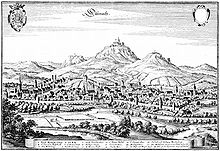
Eisenach around 1647 (copper engraving by Matthäus Merian)
-DE.svg.png)
Thuringia and adjacent areas around 1685. The region was fragmented into a number of smaller dominions, one of which was the Duchy of Saxe-Eisenach.
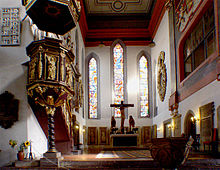
Interior of the Georgenkirche with the baptismal font in which Bach was baptised
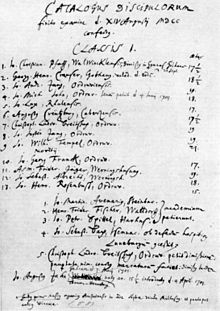
School register of the Lyceum Ohrdruf. J. S. Bach is the fourth pupil in the second list
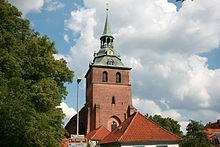
St. Michaelis in Lüneburg
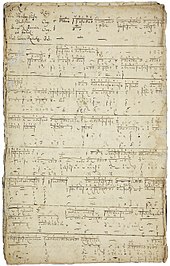
Bach's copy of Reincken's An Wasserflüssen Babylon, notated in organ tablature
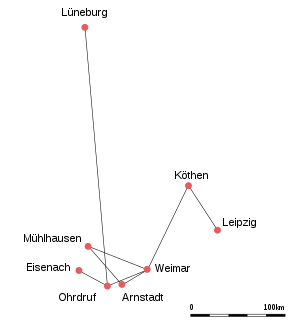
Residences of Johann Sebastian Bach
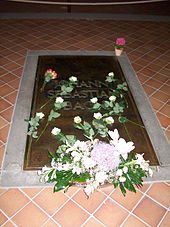
Tomb of Johann Sebastian Bach in St. Thomas Church
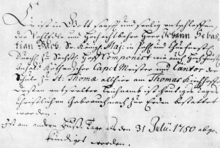
notice of discontinuance dated 31 July 1750
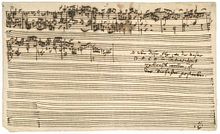
Autograph of the end of the unfinished last fugue from the Art of Fugue with Carl Philipp Emanuel Bach's addition: "NB above this fugue, where the name BACH has been placed in the contrast subject, the author has died.

Zimmermannisches Caffee-Hauß (right), place of the musical concerts, or gatherings

360° New Bach Monument in Leipzig Show as spherical panorama
_Foto_H.-P.Haack_bearbeitet.jpg)
St. Thomas Church in Leipzig 1749 (copper engraving)
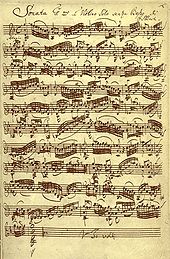
Sonata 1ma á Violino Solo senza Baßo di JSBach : Adagio; Autograph 1720
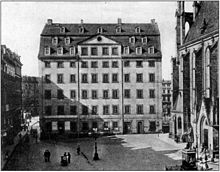
Photograph of the Thomas School in Leipzig from 1896. Bach's family lived in the left third of the house.
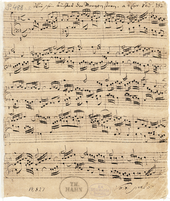
Autograph of the chorale arrangement Wie schön leuchtet der Morgenstern BWV 739 from Bach's Arnstadt period, Staatsbibliothek zu Berlin - PK
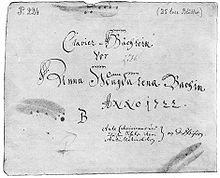
Clavier-Büchlein before Anna Magdalena Bachin Anno 1722 , cover page

Bach's own handwritten name on the flyleaf of the cantata Gott ist mein König, 1708. He writes himself in Italian as Gio. Bast. Bach (= Giovanni Bastiano Bach)

Christian Richter (c. 1660): Weimar Castle Church, Bach's place of work

Accounting of salary payments in Weimar: "Dem Laqueÿ Baachen".
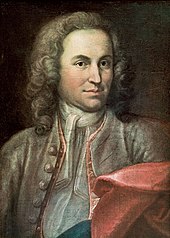
J. E. Rentsch the Elder: Bach (?) as concertmaster in Weimar, 1715
.jpg)
Köthen around 1650 (copper engraving)
.svg.png)
Anhalt-Köthen was one of four Anhaltinian principalities
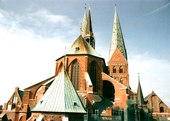
St. Mary's in Lübeck
Reception
During his lifetime
During his lifetime, Bach's compositional output received only limited attention, compared to that of his contemporaries Georg Friedrich Händel or Georg Philipp Telemann, for example. However, he was certainly no "misunderstood genius", but was known throughout Europe by music connoisseurs such as Johann Mattheson and Giovanni Battista Martini. After his death, a list of the "most famous German musicians" appeared in the same volume of Mizler's Musikalische Bibliothek in which the necrology was also printed in 1754. The order chosen there is as follows: 1st Hasse, 2nd Handel, 3rd Telemann, 4th the two Grauns, 5th Stölzel, 6th Bach, 7th Pisendel, 8th Quantz, and 9th Bümler. Bach was known throughout Europe during his lifetime primarily as an organist and harpsichord virtuoso, as well as a master of improvisation. The music critic Johann Adolf Scheibe wrote in 1737 about Bach's abilities as a virtuoso:
"I have heard this great man play several times. One is amazed at his skill, and one can hardly understand how it is possible that he can interlock his fingers and his feet so strangely and so nimbly, extend them and make the longest leaps with them, without mixing in a single false note or disorienting the body by such a violent movement."
- J. A. Scheibe: Der Critische Musicus, Sechstes Stück, Hamburg, 14 May 1737
The polymath and Lutheran pastor of Bach's wedding church in Dornheim, Johann Gottfried Gregorii alias Melissantes, who was of the same age, counted Bach in 1744 as one of the best German organists, just like Johann Georg Ahle or Bach's pupils Johann Heinrich Buttstett and Johann Ludwig Krebs, in a professional treatise.
Frederick the Great could still remember Bach's outstanding improvisational skills 27 years after his visit to Potsdam:
" Entre autres [Frédéric II] il me parla [de] musique, et d'un grand organiste nommé [Carl Philipp Emanuel] Bach, qui vient de faire quelque séjour à Berlin, cet artiste est doué d'un talent superieur à tout ce que j'ai entendu ou pu imaginer en profondeur de connoissances harmoniques et en force d'exécution; cependant ceux qui ont connu son Père ne trouvent pas encore qu'il l'egale, le Roi est de cette opinion et pour me le prouver il chanta à haute voix un sujet de Fugue chromatique, qu'il avoit donné à ce vieux Bach, qui sur le champ en fit une Fugue à 4 puis à 5, puis enfin à huit voix obligés. »
"Among other things, [Frederick II] spoke to me about music and a great organist named [Carl Philipp Emanuel] Bach, who has just been in Berlin. This artist is endowed with a talent that surpasses anything I have ever heard or could have imagined, in terms of profundity, understanding of harmony, and strength of musical execution. Nevertheless, those who still knew his father think that his son could not have equalled him; the King agreed, and to prove it he sang to me in a strong voice a theme of a chromatic fugue which he had given to old Bach, whereupon he witnessed the latter improvise from a standing start a fugue to 4, then 5, and finally eight [!] obbligato voices upon it."
- Gottfried van Swieten (Austrian envoy in Berlin): Letter to Count Kaunitz dated 26 July 1774
Johann Gottfried Walther, a friend of Bach's, describes Bach's career to date quite precisely in his Musicalisches Lexicon of 1732, but restricts himself in the specification of his works to the excellent piano works published in copper in 1731, namely the six partitas.
Handing down through sons and pupils
After Bach's death, there was initially little desire to continue performing his works. It was also unusual at this time, as is the case in today's concert life, to publicly perform works by long-dead composers of the past in concerts. Musical taste in the post-Bach era yearned for a more "natural" and "sensitive" style of music. Bach's music was often perceived as artificial and unnatural. In the words of the already quoted Scheibe:
"This great man would be the admiration of whole nations if he had more comfort and if he did not rob his pieces of their naturalness by a turgid and confused nature and obscure their beauty by too great an art. Because he judges by his fingers, his pieces are exceedingly difficult to play; for he demands that the singers and instrumentalists should do through their throats and instruments exactly what he can do on the piano. But this is impossible. [...] one admires [...] the arduous work and an exquisite effort, which is nevertheless applied in vain, because it goes against reason."
- J. A. Scheibe: Der Critische Musicus, Sechstes Stück, Hamburg, 14 May 1737
Most of the Thomaskantors of the late 18th century also cared little for the performance and preservation of their predecessor's compositions. Apart from a few music lovers, Bach's memory was preserved above all by his sons, who were taught by him and had become composers themselves. However, they certainly went their own ways.
· 
Wilhelm Friedemann Bach,
the Dresden or Halle Bach
(1710-1784)
· 
Carl Philipp Emanuel Bach,
the Berlin or Hamburg Bach
(1714-1788)
· 
Johann Christoph Friedrich Bach,
the Bückeburg Bach
(1732-1795)
· 
Johann Christian Bach,
the Milan or London Bach
(1735-1782)
Another son, Johann Gottfried Bernhard Bach, caused his father most of his worries. At the age of 23, he suddenly disappeared from his position as organist in Sangerhausen, leaving behind a mountain of debt, and died a year later in Jena of a "hot fever".
Throughout his creative period, Bach was active as an instrumental and composition teacher, and a total of 81 pupils can be traced. These lived, often for a long time, in the family household and later often took important Kapellmeister and cantor posts. It was they, along with his sons, who kept Bach's name and musical legacy alive in the second half of the 18th century. Well-known pupils of Bach were Johann Ludwig Krebs and Johann Philipp Kirnberger, who passed on Bach's compositional theory and Well-Tempered Tuning. As a result, many of Bach's compositions became works of instruction for later composers, such as the youthful Ludwig van Beethoven, but were nevertheless rarely performed in public during the first eighty years after Bach's death.
Influence on the Viennese Classics
Haydn and Mozart initially meant Carl Philipp Emanuel when they spoke of Bach; he gave them, especially Haydn, decisive inspiration for their own style. Mozart was also influenced by the music of Johann Christian Bach, whom he had met as a "child prodigy" in London on a concert tour in 1764/1765. Johann Sebastian Bach only came to the attention of both of them at a late stage.
From April 1782 Wolfgang Amadeus Mozart became acquainted with works by Handel and Bach at Gottfried van Swieten's house. Mozart studied Bach's piano fugues in particular and systematically acquired their compositional techniques.
"I go every Sunday at 12 o'clock to the Baron van Swieten's, and nothing is played there but Handel and Bach - I just make myself a collection of the Bachian fugues - both Sebastian as Emanuel and Friedemann Bach [...] Then also of the Handelian ones."
- W. A. Mozart: Letter from Vienna to his father Leopold Mozart in Salzburg dated 10 April 1782
In 1789, Mozart heard Bach's motet "Singet dem Herrn ein neues Lied" (BWV 225) during a visit to St. Thomas Church in Leipzig. Exceptionally impressed, he immersed himself in this and other Bach scores. Traces of this encounter are the spontaneously composed little gigue and the increased use of polyphonic settings in Mozart's later works.
Ludwig van Beethoven studied the piano works of J. S. Bach already as a child. His Bonn teacher Christian Gottlob Neefe wrote about him in Cramer's Magazin der Musik in 1783: "He plays the piano very well and with power, reads very well at sight, and to say it all in one: he plays mostly the well-tempered piano of Sebastian Bach". After Beethoven had come to Vienna in 1792 at the age of 22, he continued to study Bach's works. In the salon of the aforementioned Baron von Swieten, he regularly played a wide variety of Bach's compositions:
"The musical pleasures in the house of van Swieten, where preferably music by Haendel, Seb. Bach and the great Italian masters, up to Palestrina, were performed with a strong orchestra, were exquisite [...] For Beethoven, these gatherings had the special feature that he not only became acquainted with those classics, but also that he always had to endure the longest, because the old man was a musical glutton [...] because Beethoven had to recite half a dozen fugues by Bach "zum Abendsegen" (for the evening blessing) on top of everything he had heard in advance."
- Anton Schindler: Biography of Ludwig van Beethoven, Münster, 1840
Beethoven dealt with Bach's polyphonic techniques and forms especially in his late works, for example in the Piano Sonata op. 110 and in the Diabelli Variations as well as in his String Quartets op. 127, op. 130, op. 131, op. 132 and op. 133 (Great Fugue). A kinship between some of Beethoven's works and the music of Bach is unmistakable; for example, the theme of the Arioso Dolente from the Sonata op. 110 is clearly borrowed from an altarpiece from Bach's St. John Passion.
Bach Renaissance in the 19th century
The first striking turning point in the perception and appreciation of Bach's work is the Bach biography of Johann Nikolaus Forkel (1749-1818). Forkel was university music director in Göttingen and also a music historian. He still knew the two Bach sons C. P. Emanuel and Wilhelm Friedemann personally and obtained a substantial part of his information through them. In the preface to the biography published in 1802, he appealed to the national sense:
"Preserving the memory of this great man is not merely a matter of art, it is a matter of national concern."
- J. N. Forkel: On Johann Sebastian Bach's Life, Art and Works of Art
In the concluding sentence of his biography, Forkel enthusiastically calls Bach "the greatest musical poet and the greatest musical declamator there has ever been and probably ever will be."
The then only 20-year-old Felix Mendelssohn Bartholdy, a pupil of Carl Friedrich Zelter, deserves credit for bringing Johann Sebastian Bach back to the attention of a broad public almost eighty years after his death - with the revival of the St. Matthew Passion in an abridged version on 11 March 1829 with the Sing-Akademie zu Berlin, founded in 1791. He thus anticipated the performance planned earlier by his friend Johann Nepomuk Schelble with his Cäcilienchor in Frankfurt, thus giving an enormous impetus to the publicity of Bach's music and ushering in the Bach Renaissance. The generation of Romantic composers born around 1810 experienced Bach's compositions as poetic music and took them as their model in many ways. For Felix Mendelssohn Bartholdy (1809-1847), Robert Schumann (1810-1856) and Frédéric Chopin (1810-1849), and even for Franz Liszt (1811-1886), Bach's works were an important basis for their own creative work. It was Mendelssohn Bartholdy, Chopin and Liszt - along with Adolf Henselt, Ferdinand von Hiller, Ignaz Moscheles, Clara Schumann, Sigismund Thalberg and many Liszt pupils - who included Bach's piano works in their concert programmes. In particular, the Concerto for Three Pianos in D minor (BWV 1063) and the Solo Concerto in D minor (BWV 1052) were frequently performed and introduced the middle-class concert public to Bach's instrumental works. All this was admittedly far from historical performance practice. The Musical Times wrote in an obituary of Mendelssohn in January 1848:
"Never shall we forget the triumphant cadence with which he concluded Bach's concerto for three harpsichords, following Moscheles and Thalberg. He alone knew the style: it was the pedal solo of an organ fugue in double octaves. What gigantic power he put into these things! The beauty of the exhibition, and, indeed, of the numerous demonstrations made by Mendelssohn in honour of Bach, was that he announced himself the disciple of a master contemned by ignorance and prejudice."
"We shall never forget the triumphant cadenza with which he ended Bach's Concerto for Three Harpsichords following Moscheles and Thalberg. He alone mastered this style: it was the pedal solo of an organ fugue in double octaves. What tremendous power he put into it! The beauty of the performance, and so of Mendelssohn's many expositions of it in Bach's honor, showed that he regarded himself as the pupil of a master long disparaged by ignorance and prejudice."
- The Musical Times, January 1848
Schumann wrote about the performance of the St. John Passion in Düsseldorf:
"For the sake of the importance of the work that we performed yesterday, a treasure that has been well buried for over a hundred years, it would be desirable for it to become known in wider circles. [...] That the attention of the German art world would be drawn to this, one of Bach's most profound and accomplished works, is something to which I would also like to contribute ..."
- Robert Schumann: Letter to Wolfgang Müller from Königswinter, Düsseldorf, 14 April 1851
Finally, from the middle of the 19th century onwards, the public was more familiar with Bach's instrumental music than with the sacred works, including the Passions. In 1850, with the participation of Schumann, Liszt, Ignaz Moscheles, Louis Spohr, Otto Jahn, Carl von Winterfeld, Siegfried Wilhelm Dehn, Carl Ferdinand Becker and the Thomaskantor Moritz Hauptmann, the Bach Society was founded in Leipzig with the aim of publishing the works of Bach in a complete edition. Johannes Brahms (1833-1897), whose musical historicism was based on J. S. Bach, was also instrumental in this first complete edition of Bach's works. When this task was completed in 1900, the Bach Society was dissolved in accordance with its statutes, and at the same time, on the initiative of Hermann Kretzschmar and with the participation of Oskar von Hase, Martin Blumner, Siegfried Ochs, Joseph Joachim, Franz Wüllner and the Thomaskantor Gustav Schreck, the New Bach Society was constituted.
20th and 21st century
It was not until the 20th century that Bach's compositions were systematically cultivated in public musical life and in musicology.
Bach's works have increasingly become the subject of historical performance practice since the 1970s. It has given many performers and listeners new access to his music. Wanda Landowska had already made a start in 1903 with her first public harpsichord recital, and with the first recordings in 1923 and the founding of the École de Musique Ancienne in 1925 she paved the way for the "original sound". However, Bach is also played on modern instruments. The recordings of the Canadian pianist Glenn Gould on a modern grand piano, characterized by clarity and a deep understanding of counterpoint, are considered milestones of Bach interpretation.
In the 20th century, Bach's work also underwent a number of popular adaptations. Many of these are trivial and have only a quoting character, but there have also been more serious approaches - for example by Jacques Loussier with his Play Bach project, by Ward Swingle with his Swingle Singers and by Walter Carlos, who opened up a new sonic perspective on Bach's work with his Moog synthesizer. Jazz musicians in particular have repeatedly found inspiration in Bach's concertante polyphony and in his fugue technique, for example Nina Simone, Dave Brubeck and Keith Jarrett. Even in pop and rock music (e.g. Deep Purple, Ritchie Blackmore, The Nice and Ekseption) there are borrowings from and influences by Bach. The spectrum ranges from inspirations with no precisely identifiable references (such as Paul McCartney's song Blackbird, which differs from Bach's Bourrée in E minor BV 996 in its meter, key and melodic line) to deliberate deconstructions (such as François Sarhan's alienating arrangement of Bach's Prelude and Fugue in C major BWV 846). While a paraphrase merely imitates a compositional style (such as Bach's Air BWV 1068 in A Whiter Shade of Pale by the British band Procol Harum), a quotation is a literal takeover and designed to make the original and its surroundings recognizable (as in the case of numerous Bach quotations by the band "The Nice"). Adaptations, on the other hand, are based on shortened arrangements of the original (such as Jethro Tull's re-instrumented arrangement of Bach's Bourrée).
There are also numerous Bach references in contemporary art music. Alban Berg had already given central importance to the chorale quotation "Es ist genug" (from the cantata O Ewigkeit, du Donnerwort, BWV 60) in his Violin Concerto (1935), and more recently Klaus Huber based his composition Senfkorn (1975) on a passage from the bass aria "Es ist vollbracht" (from the cantata Sehet! Wir gehn hinauf gen Jerusalem BWV 159). Isang Yun used the theme from the Musical Offering in his solo violin work Königliches Thema (1976), as did Jürg Baur in Kontrapunkte 77. Edison Denissow composed variations on "Es ist genug" in 1984 (ensemble version 1986). Meditations on the Bach chorale "Vor deinen Thron tret ich hiermit" (BWV 668) were written by Sofia Gubaidulina in 1993, while Reinhard Wolschina gave his moments of silence (2000) the subtitle five postludes for J.S.B. Jörg-Peter Mittmann reflects on Bach's C minor Passacaglia BWV 582 in his work Passacaglia (2006). In ...mit Bach (2002) the same composer unfolds a sound surface over the chorale "Jesus bleibet meine Freude" (BWV 147).
The motif B-A-C-H alone, which Bach himself wove into the last piece of his Art of Fugue, has been taken up by more than 300 composers, for example by Hanns Eisler in Prelude and Fugue on B-A-C-H (1934). Arvo Pärt composed a collage on B-A-C-H (1964), which he later expanded into the Concerto Piccolo on B-A-C-H (1994). In Vagues (Hommage à J. S. Bach) (2006), Jean-Luc Darbellay alludes to Beethoven's saying "Not Bach, Meer soll er heißen" ("Not Bach, his name should be Meer") and likewise draws on the motif B-A-C-H.
The Bachianas brasileiras (1930-1945) by Heitor Villa-Lobos are not a Bach reference in the strict sense.
Commemorate
Memorial Days
- Bach in the Subways: March 21, since 2011, 2015 in subways in 129 countries, ten of which are in Germany.
- Evangelical Church in Germany: 28 July in the Evangelical Name Calendar
- Evangelical Lutheran Church in America: 28 July
- Lutheran Church - Missouri Synod: 28 July
Monuments and commemorative plaques
Numerous monuments were erected in Bach's honor, especially in the 19th and early 20th centuries. These include, among others:
- 1843: The Old Bach Monument in Leipzig (1843) near St Thomas's Church. It was donated by the composer Felix Mendelssohn Bartholdy, designed by Eduard Bendemann, Ernst Rietschel and Julius Hübner and executed by the Leipzig sculptor Hermann Knaur. It is considered the world's oldest monument to Bach.
- 1884: The monument in Bach's birthplace Eisenach in front of the Bach House. This sculpture was designed by Adolf von Donndorf in 1884 and executed by Hermann Heinrich Howaldt.
- 1885: The Bach monument in Köthen. It was created in 1885 by the Berlin sculptor Pöhlmann. It stands in front of the Bach House in Köthen.
- 1899: Secondary bust to the central statue of Frederick the Great in monument group 28 of the former Berlin Victory Avenue by Joseph Uphues, unveiled on 26 August 1899. The bust is lost.
- 1908: The much better known New Bach Monument, also located in Leipzig, on the Thomaskirchhof. On a 3.20 m high shell limestone plinth, designed by the Leipzig architect and city architect Otto Wilhelm Scharenberg and bearing the name of the honoured, is a 2.45 m high bronze statue designed by the Leipzig sculptor Carl Seffner and cast by the firm Noack & Brückner. It was unveiled in 1908.
- 1939: Bach memorial by the Berlin sculptor Paul Birr (1887-1945, missing) in the vestibule of the Georgenkirche in Eisenach, Bach's baptismal church.
- 1950: On the occasion of the Bach Year 1950, a bust of Bruno Eyermann (1888-1961) was unveiled at the Platz der Demokratie in Weimar, but it was removed again in 1952. It was not until 1995 that it was re-installed.
- 1985: Monument of the young Johann Sebastian Bach by the sculptor Bernd Göbel on the market place in Arnstadt, unveiled 1985
- 2009: At the Bach memorial next to his place of work Divi Blasii in Mühlhausen/Thuringia, the young Bach stands next to his memorial pedestal. It was created by the sculptor Klaus Friedrich Messerschmidt and unveiled on 9 August 2009.
Music festivals
Music festivals are held in honour of the composer at various places where Bach worked and other cultural centres. The Bach Festival Leipzig has been held since 1908. Every two years, the Köthener Bach Festival is held in Köthen as part of the Saxony-Anhalt Music Festival. The Thuringian Bach Weeks are the largest festival of classical music in Thuringia. The Ansbach Bach Week has been held since 1947. The Frankfurt Bach Concerts were launched in 1961 and the Würzburg Bach Days in 1969.
Bach Planetoids
As a special form of tribute, the naming of newly discovered celestial bodies after historical personalities has been in use for over 100 years. Nine planetoids in the Sun's asteroid belt have already been named after Johann Sebastian Bach, including the most important places where he worked. Planetoid No. 1814 (1931 TW1), discovered by K. Reinmuth in 1931, bears the official name Bach.
Stamps and coins
Bach and his works are depicted on numerous German and foreign stamps and coins.
Forest
On the western shore of Lake Störmthal near Leipzig, the Johann Sebastian Bach Forest is being planted with the support of the Bachfest Leipzig. In Störmthal Bach tested the organ built by Zacharias Hildebrandt in 1723, which was inaugurated with the cantata Höchsterwünschtes Freudenfest (BWV 194) composed by Bach for the occasion.
Movies
- Johann Sebastian Bach's futile journey to fame. Feature film, 107 min., GDR, BR Germany 1979/1980. Director: Victor Vicas, Production: DEFA, ZDF
- Johann Sebastian Bach. Television film in four parts, GDR, Hungary 1983/1984, 1. the challenge, 85 min. - 2. are you with me ..., 90 min. - 3. storms and years, 80 min. - 4. the order of the stars, 90 min. director: Lothar Bellag, Ulrich Thein as Johann Sebastian Bach, Angelika Waller as Maria Barbara Bach.
- A Monument for Johann Sebastian. Documentary, 19 min., GDR, 1984 Director: Peter Milinski, Production: DEFA-Studio für Dokumentarfilme, Bereich Kinofilm Kleinmachnow, AG Effekt. Matthias Eisenberg, Gewandhaus organist, and Hans Wintoch, rock musician, talk about their attitude to Johann Sebastian Bach.
- Johann Sebastian Bach - Stations of his Life (2 episodes) - documentary, GDR, 1984. Director: Peter Milinski, Production: DEFA-Studio für Dokumentarfilme, Bereich Kinofilm Kleinmachnow, AG Effekt. 1st episode: I have had to be industrious, 2nd episode: I have chosen this as my dwelling. J. S. Bach - stations of his life in Eisenach, Arnstadt, Mühlhausen, Dornheim and Weimar and his work in Köthen, Halle, Dresden and Leipzig.
- My Name is Bach. Feature film, 99 min., Germany, Switzerland, France, 2002/2003. Directed by Dominique de Rivaz, depicts the meeting of Bach (Vadim Glowna) and Frederick II (Jürgen Vogel) in 1747.
- Chronicle of Anna Magdalena Bach - feature film, 90 min., D 1967. directed by Jean Marie Straub and Danièle Huillet; Gustav Leonhardt as Johann Sebastian Bach, Christiane Lang-Drewanz as Anna Magdalena Bach, with Concentus Musicus Wien, Nikolaus Harnoncourt, Schola Cantorum Basiliensis, August Wenzinger, Knabenchor Hannover
- Great Composers (BBC TV series) - The life and works of J. S. Bach (English), 8 parts: Part 1, Part 2, Part 3, Part 4, Part 5, Part 6, Part 7, Part 8.
- Bach: A Passionate Life - John Eliot Gardiner, BBC programme on the life of Bach from 28 April 2013 (English)
- The Silence before Bach. Film, 102 min., Spain 2007. Directed by Pere Portabella, set to the music of Johann Sebastian Bach, presented at the Venice International Film Festival 2007, with Christian Brembeck as Johann Sebastian Bach, Daniel Ligorio as Felix Mendelssohn, Alex Brendemühl, Féodor Atkine, Thomaskantor Georg Christopher Biller and others.
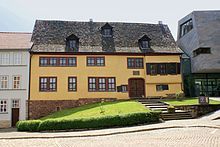
The Bach House in Eisenach serves today as a museum, but it is not Bach's birthplace.
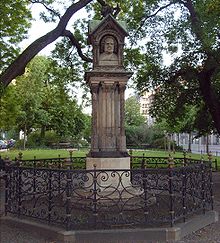
The old Bach monument in Leipzig from 1843, donated by Felix Mendelssohn Bartholdy

Bach in the Subways 2015 in Leipzig
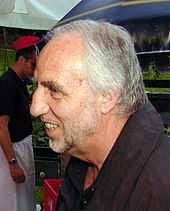
Jacques Loussier became known for his modern interpretations of Bach's works with his Play-Bach-Trio.
Questions and Answers
Q: When and where was Johann Sebastian Bach born?
A: Johann Sebastian Bach was born on March 31, 1685 in Eisenach, Germany.
Q: What is Johann Sebastian Bach most famous for?
A: Johann Sebastian Bach is most famous for his work Toccata and Fugue in D Minor, St. Matthew Passion, St. John Passion, Mass in B minor, and the Brandenburg Concertos.
Q: Where did Johann Sebastian Bach work during most of his life?
A: During most of his life, Johann Sebastian Bach worked in a church where he was expected to write church music.
Q: What kind of music did Johann Sebastian Bach write?
A: Johann Sebastian Bach wrote almost every kind of music except opera.
Q: Did Johann Sebastian Bach always write in the Baroque style?
A: Yes, Johann Sebastian Bach always wrote in the Baroque style, even when most composers were writing in a new style called the Classical style.
Q: How is Johann Sebastian Bach regarded today?
A: Johann Sebastian Bach is regarded as one of the greatest composers who has ever lived, along with Mozart and Beethoven.
Q: Where did Johann Sebastian Bach write most of his chamber music and orchestral music?
A: Johann Sebastian Bach wrote most of his chamber music and orchestral music while working at courts of noblemen.
Search within the encyclopedia
